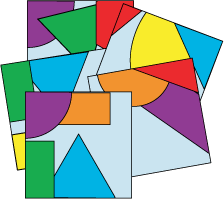Or search by topic
Number and algebra
Geometry and measure
Probability and statistics
Working mathematically
Advanced mathematics
For younger learners
Jig Shapes



- Problem
- Getting Started
- Student Solutions
- Teachers' Resources
Jig Shapes
This challenge is best done in a group of at least four children.

You'll need to print out this sheet or, if you would like much larger cards, these sheets. The sheets will need to be cut into twelve separate cards.
Share all the cards out amongst the group.
Can you each work out what shape or shapes you have part of on your card?
Can you describe the shapes without showing it to anyone else?
What will the rest of the shape or shapes look like do you think?
How could you sort the cards?
We would love to hear your descriptions and hear about the ways you sorted or arranged the cards.
This problem is also available in French, called Casse-tête de formes.
Why do this problem?
The intention of this problem is that children will work together as a team. It should help in developing mathematical language about shape and position, as well as encouraging learners to listen carefully to others and tweak their own ideas accordingly.
You may like to read our Let's Get Flexible with Geometry article to find out more about developing learners' mathematical flexibility through geometry.
Possible approach
The cards have been designed to join together like a jigsaw so that the picures of the shapes are complete, but it may be better not to tell children this immediately. Instead, invite the group to find a way to organise or sort the cards. At this stage, members of the group can help each other find adjoining cards, but discourage them from simply giving someone else their card. If you are doing the problem as a class activity you could use sticky-tack to fix the cards to the board. Encourage the children to describe the shapes they can see as the whole 'jigsaw' is built up.
Alternatively, you could invite each group to hide two of the cards and challenge them to create the jigsaw without them. Can they draw what they think is on the missing cards? Is there more than one possible solution? Does the position of the missing cards in the jigsaw make a difference to how difficult it is to draw them?
Key questions
Possible extension
Learners who think this activity is trivial have not solved the problem! How can the cards be organised, arranged or ordered? Encourage them to help other members of the team in a cooperative spirit. They can also be challenged to make their own Jig-shape puzzle using all the geometric shapes they can.
Possible support
It may be appropriate for some children to share cards with someone who is more confident with language about shape than they are themselves.
You may also like
Biscuit Decorations
Andrew decorated 20 biscuits to take to a party. He lined them up and put icing on every second biscuit and different decorations on other biscuits. How many biscuits weren't decorated?

